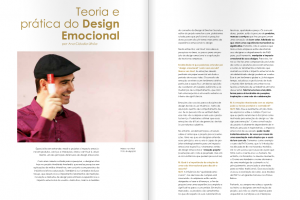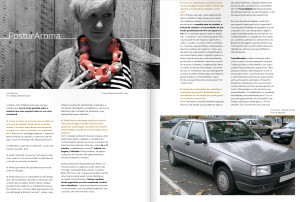This interview that Ideia magazine had with MediaLAB team member Marco van Hout was originally published in Idea Magazine in Portuguese (Brazil). Below, you can read part of the English translation. On Marco’s website, you can download the original. Marco talks about what emotional design is, how organisations can adopt it, what methods and approaches can be used and what the Design and Emotion Society stands for. In the Interview, the Posturaroma project is presented as a clear example of design for emotion, using embodiment.
The PosturAroma neckless and project will be presented at the 9th International Design & Emotion Conference in Bogota, Colombia.

The interview:
ID: What can we understand by ” emotional design ” this new century?
MvH: Emotions play a vital role throughout the span of our lives. Strictly speaking, the concept of emotion refers to a particular and specific affective phenomenon: a brief episode of coordinate brain, autonomic, and behavioural changes that facilitate a response to an external or internal event of significance.
Emotions are crucial for the design discipline because of their influence on both purchase and usage behaviour: if it does not feel good, people will not buy it nor use it. One might state that these emotions are hard to manage, because of their subjective nature. However, there are universal principles in the way that (product/service) design evokes emotions (sourse: P.M.A. Desmet). Once a designer understands these principles, he or she is able to strategically design for a specific emotional impact. This is referred to as emotional design, or as I prefer to say: emotion-driven design (the emotion itself is not designed, but rather the circumstances that may evoke it).
ID: What is the importance of creating an international network to discuss it ?
MvH: The influence of the ‘emotional quality’ of consumer products on purchase decisions is growing. Companies are forced to make the difference on the basis of providing a full and meaningful experience for the consumer. Nowadays it is more difficult to distinguish products based on their technological advances or quality. In many markets, products are similar in respect to their technical characteristics, quality and price. Consumers however are looking for products, brands and services that give them a feeling of wellbeing, happiness or create a memorable or meaningful experience. It is therefore no surprise that more and more companies are challenging their designers and R&D department to (positively) manipulate the emotional impact of their designs. For them, it becomes vital to have a profound understanding of how products elicit emotions and how tools and methods that evaluate or create the emotional impact of a certain design can be used.
This is a global phenomenon and for some time now, scholars and practitioners all around the world have been trying to find new ways and theories around this theme. It makes sense to try and gather all of these efforts in order to get both the field as the level to the next level. We provide a platform for research exchange, inspiration and a network for collaboration.
ID: As the emotion related to the objects can become predictable and controllable ?
MvH: No, this is actually one of the bigger misconceptions about the field. That is why I prefer to refer to the discipline as emotion-driven design or ‘design foremotion’. The emotional impact is the aim, but cannot be compared to designing a button’s functionality that either turns a device on or off. With emotion-driven design, it is highly dependent on someone’s personal concerns, expectations, the context and circumstances in which the button is used whether or not it will evoke either joy or frustration (or any other emotion). The emotional impact of your design can change instantly, sometimes because of the simplest association that the user has with it. Take for example the car the FIAT Croma, which was introduced in the 80s in the Netherlands. In Italy it was a success because of the fit it had with the targeted customer: men. However, in the Netherlands, at the time Croma was also the brand name of a baking butter and was mostly advertised and targeted at traditional moms. As this association overshadowed the evaluation of the actual car, this model of FIAT was a big flop within the Netherlands.
Therefore I always stress when I train designers in emotion-driven design that it is all about orchestrating the right conditions and interactions, but to also realize they will never have a guarantee on the impact it will eventually have on an emotional level.
ID: How to engage the emotions of users in the design process ? What are
the methods , theories and specific techniques to arouse emotions or
avoid a particular product ?
MvH: In order to strategically include the emotional impact of your design in the design process, you can distinguish three main steps: 1) Understand (what are emotions, how are they evoked, etc.), 2) Measure/ Explore (what emotions does a concept or existing solution evoke, and more importantly sometimes, which aren’t evoked?), 3) Target (which emotions would you like to evoke with your design) and 4) Design (design features and characteristics in such a way that they support the targeted emotions to be evoked). Within these steps there are many methods and tools that are available in order to get insights. At the website of the Design & Emotion Society (www.designandemotion.org) we have a broad collection of tools and methods and a lot of academic papers in our library from previous conferences that introduce you to such methods.
ID: What are the main projects developed by The Design & Emotion Society
today? What are the main examples of products developed from their
interaction with the public ?
MvH: The Design & Emotion Society offers a platform for discussion and the sharing of knowledge through our bi-annual international conferences. This year, from 6-10 October, we will celebrate our 9th edition in Bogota, Colombia. I invite everybody to come and participate. Researchers, designers and people from industry will present their recent work in the field.
Another important platform we have is the initiative for local chapters. We have several from Chicago, Amsterdam, the UK, Australia to Brazil. On our website, people can apply for a license by reading our guidelines and submitting a good plan. Our local chapters organize occasional events, seminars and initiatives, which is really good for the community to also work together on a more local level.
ID: How can organizations encourage their designers to be aware of the
emotional aspect of products and services ?
MvH: FIrst of all, an organization needs to adopt the idea that they will need to start by developing an ecosystem in which empathy for users, the beauty of creation and the necessity of deep questioning (everything) have a central role. If it is left only to the designers to ‘care’, there will be no final product that can have a meaningful impact on the user and his/her wellbeing and feelings. Managers, researchers, marketeers, business developers, they should all have a shared passion and acknowledgement for the affective and emotional impact of what they are designing, producing and selling. Once this ecosystem exists, an organization should make sure that there is enough time, resources and facilities that can make sure every stakeholder in the company can spend time on understanding, exploring and (strategically) designing for a truly ‘emotional’ end product.
ID: What are the principles that guide the emotive design ? What are the
traits of an object that can generate an emotional relationship?
MvH: To shortly mention a couple of design techniques that can be applied to improve the emotional impact of a design. For instance, you can focus on (1) Personality, (2) Embodiment, (3) Anthropomorphism or (4) Appraisal, in order to appeal to specific emotions. In the case of personality you are looking to include personality traits in the product experience. In case of digital products this can be in tone of voice, behavior or appearance, or think of the cute headlights of the Volkswagen Beetle that give it its character and therefore evoke certain pleasant emotions with people who find that also cute.
Embodiment is about the relationship between our bodies and our felt emotions. Certain body postures or movements can induce specific emotions. For example, research has shown that while moving upwards, you are more inclined to feel positive emotions than when moving down. While designing the interactions with your products you can take this type of insights into account. An example is a concept I recently worked on for MediaLAB Amsterdam, commissioned by Cisco, and will be presented at the Design & Emotion conference in Bogota: PosturAroma. A neckless that intends to support women to feel safer in public space by detecting slouching behavior and giving out a scent to the user in order to remind her to stand or walk more upwards. This to make them feel more positive and have a more confident expression.
Anthropomorphism is about the human tendency to attribute human-like qualities to non-living objects. This includes physical characteristics (like of shape and size), but also qualities of behavior and interaction. People attribute human qualities to toys, products, and machines, and we design toys, products, and machines to enhance this process. Our anthropomorphic perceptions and ideas influence how we interact with animals, robots, and products– how much we like them, how much we trust them, and definitely how we feel about them. Typical examples of applications are stuffed animals with human features, but more subtle applications can be found as well, think about the stand-by indicator (light) on the Macbook Pro, which seems to ‘breath’ human-like as it were a person that is sleeping.
An appraisal, in the cognitive tradition of emotion psychology, is defined as a quick evaluation of a situation with respect to one’s well-being. In relation to design, my fellow board member of the Design & Emotion Society, Prof. Pieter Desmet, investigated how product appearance evokes emotions and proposed that appraisal theory can be used to explain how products elicit emotions. A product appraisal is an automatic assessment of the effect of a product on one’s well-being. Pieter proposed four main types of product appraisals: the relation of a product to one’s goals, the sensorial appeal of the product, the legitimacy of an action represented by the product, and the novelty of the product. By looking at the effect on one’s well-being based on the different product appraisals, you can design specific product characteristics that can support the well-being of a targeted user. This approach has a lot of potential if you have a good understanding of whom you are designing for. The other approaches I mentioned before have more potential if you like to focus on more universal principles of emotional impact.
ID: What are the main features that a designer should exercise to get
forward , to his work , the perception that will generate a product
with emotional design ?
MvH: Emotions are crucial for the design discipline because of their influence on both purchase and usage behaviour: if it does not ‘feel’ good, people will not buy it nor use it. One might state that these emotions are hard to manage, because of their subjective nature. However, there are universal principles in the way that (product/ service/ interaction) design evokes emotions. Once a designer understands these principles, he or she is able to strategically design for a specific emotional impact. Furthermore it makes sense to use tools and methods that help to empathize with the user on an emotional level and after, also think of techniques such as I mentioned before to be able to optimize the emotional impact of your final design.
Original post: http://www.marcovanhout.com/interview-on-design-and-emotion-for-idea-magazine/


